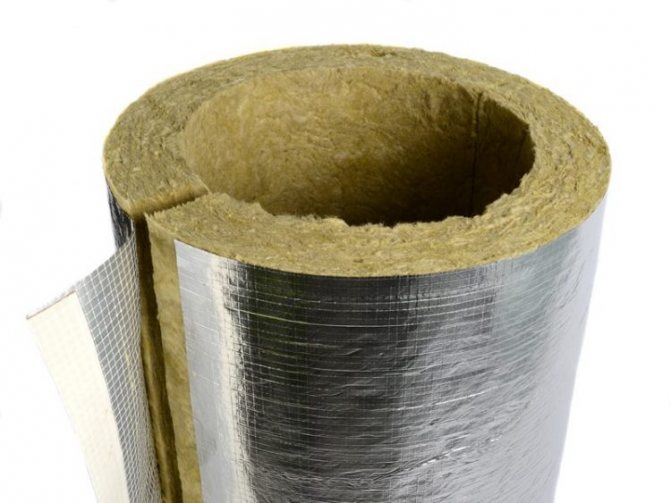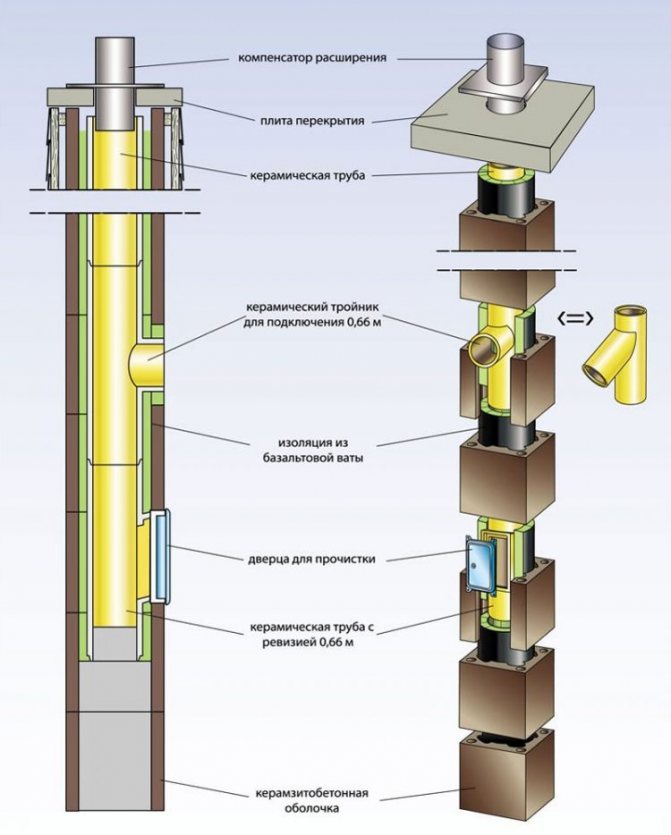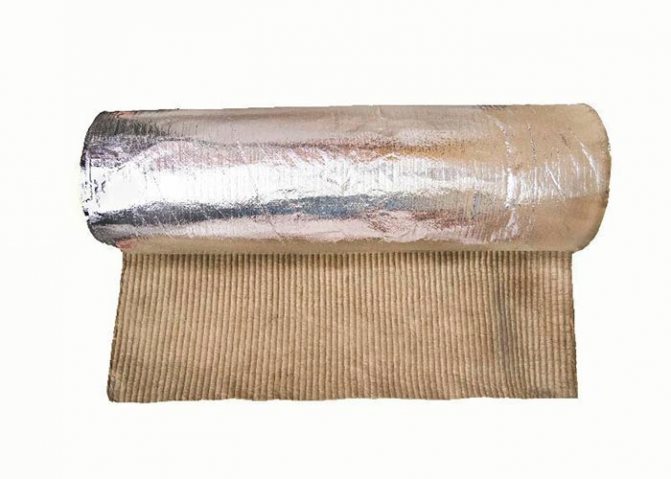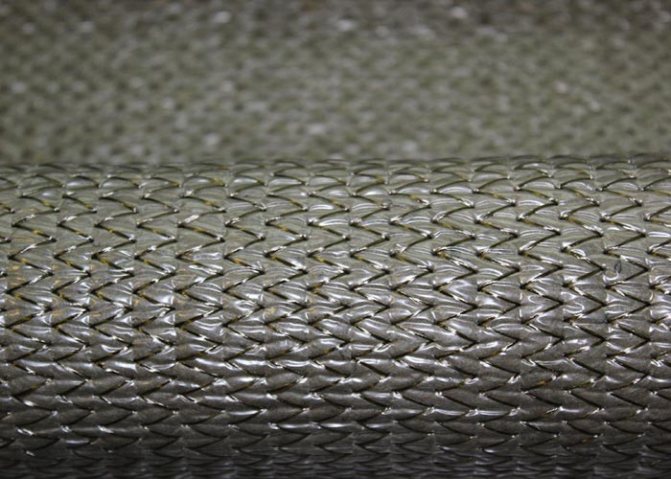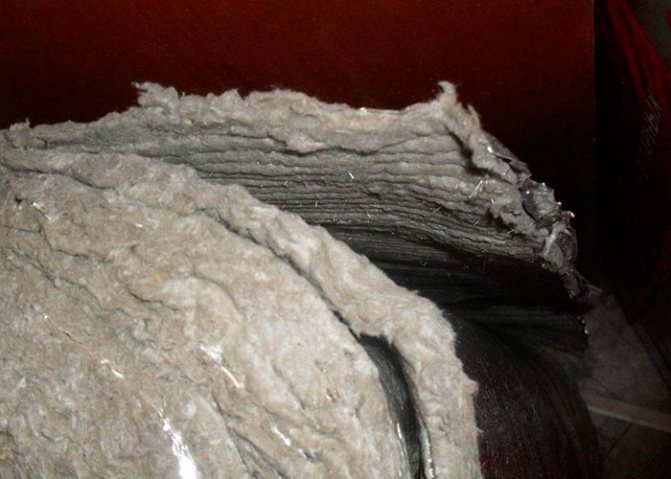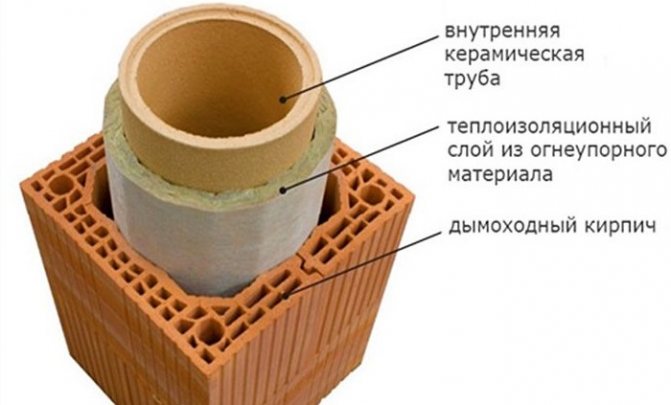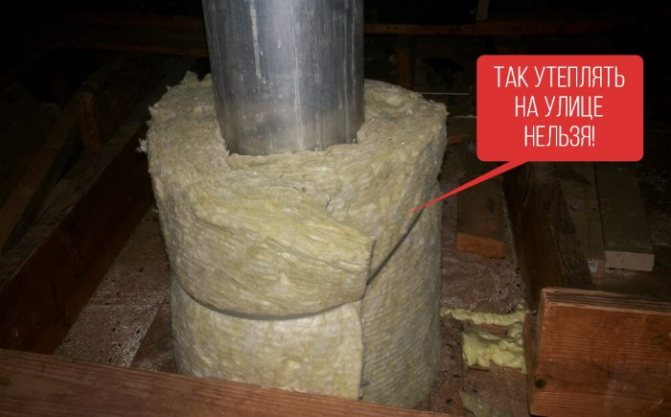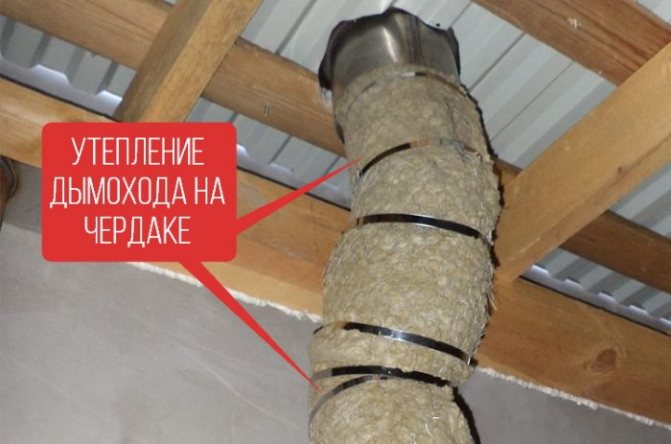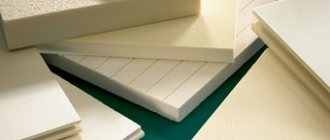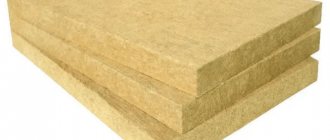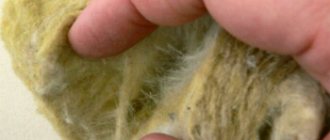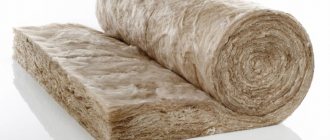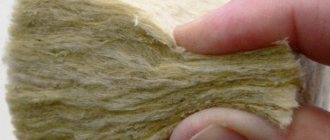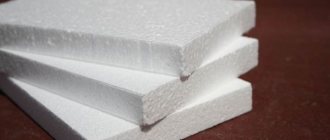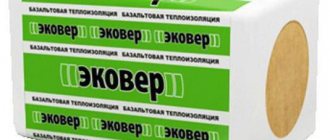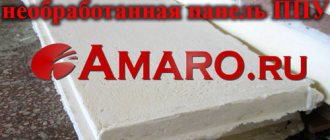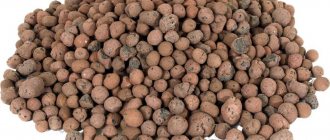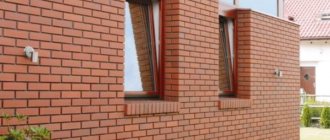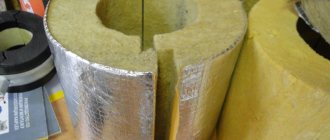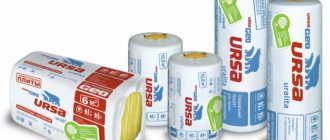Insulation is an indispensable element in the construction of any facility in temperate and cold latitudes. Room comfort and monthly heating costs depend on this. But when choosing a building material, you need to think not only about its basic functional characteristics, the fire resistance of the insulation is a vital parameter. The safety of people's lives and the safety of property largely depend on it. Today the market offers a large selection of heat insulators, and it is not difficult to choose a modification that meets all the requirements. Due to the growth of emergencies, it is better to initially choose non-combustible insulation.
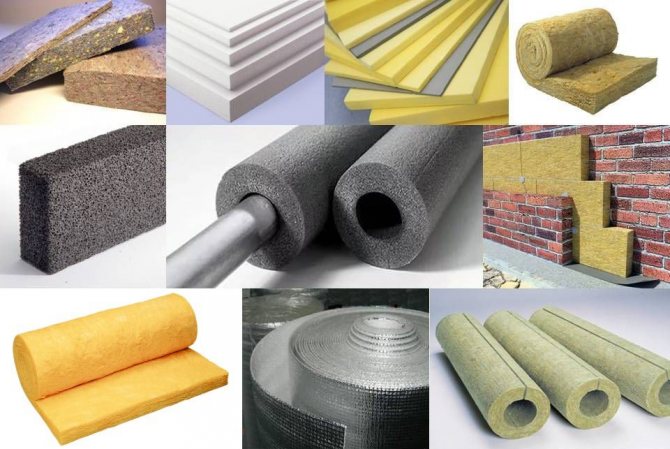
Varieties
There are hundreds of types of thermal insulation materials on sale. They differ not only in their purpose - refractory insulation for the chimney, for the foundation, for the roof, but also in structure:
- Loose. These insulators are granules and pebbles of various fractions. Building materials are poured into the voids of building structures. Expanded clay, perlite and vermiculite are well known.
- Cellular. Foamed materials are widely used in housing construction. They have good performance parameters. For example, foam glass is extremely durable, and the declared resource is 100 years.
- Liquid. These heat insulators are applied to structures in liquid form. After solidification, they turn into a white mass, similar in appearance to polystyrene. A popular liquid heat insulator is PU foam urethane.
- Fibrous. Insulation consists of fibers, building materials are often called wool: stone, mineral, basalt. On the market they are offered in mats or rolls. Traditional solution with high fire resistance.
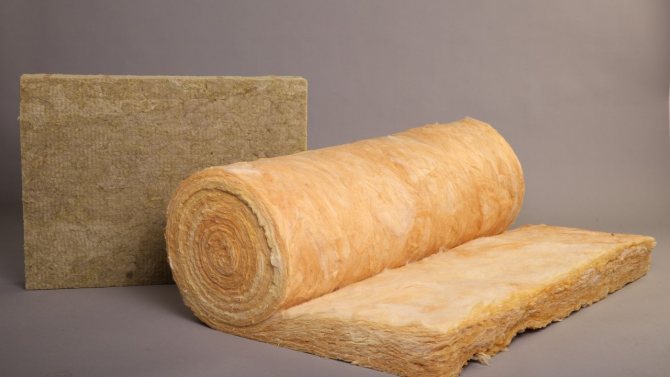

Basalt wool
Classification
Heat-insulating fibrous materials are mineral non-combustible heaters made of glass, basalt fiber, which can withstand 500 ° C. They are used in specific places:
- for insulating pipelines in the form of cylinders with foil reinforcement;
- thin mats, plates for flashing plastic windows;
- basalt - for wall, roof and floor insulation.
According to GOST, wool is divided into the following categories: stone, glass, slag wool. All types of cotton wool according to the same GOST have a flammability class NG - the oxygen index is at least 30%. Let's consider each of the types in more detail.
Glass wool
Glass wool is made from fiberglass by melting glass and stretching it from the fibers.
This material is very fire resistant, has low hygroscopicity, good sound insulation and low thermal conductivity.
The strength is higher than that of stone wool, but the fibers are still fragile, so it is better to wear gloves and glasses when working with it.
Stone wool
Basalt fiber wool is produced by melting rocks at high temperatures (up to 1500 ° C). The fibers are adhered by the addition of special substances, which gives durability. Basalt wool does not deform, does not react to acid-alkaline environments.
The additives contain phenol-formaldehyde resins that give off harmful fumes. However, evaporation begins only when heated to 700 ° C - i.e. there is no danger under normal conditions.
Slag wool
It is produced by processing slags and obtaining glassy fibers.
Such insulation has a high thermal conductivity and absorbs moisture, reacts to dampness and creates an environment that is aggressive for metals. It has one advantage - low price.
Linen insulation
It is also worth mentioning the novelty of modern production of thermal insulation materials in the form of Hot-Flax linen insulation. It is pure flax (fibers) without mineral wool admixtures, which has a fire retardant treatment and does not support combustion at all.
The oxygen index is 37%, approaching polymeric, self-extinguishing materials.
We invite you to familiarize yourself with: Spray-on insulation in cylinders polinor
How to choose a fireproof refractory heat insulator?
Regardless of why you buy an insulator with fire resistance - for a balcony, door insulation, for a boiler, floor or pipe, you need to strive for the following parameters:
- Maximum thermal efficiency. The lower the coefficient of thermal conductivity, the more heat will remain in the premises.
- Reliability. The material should be designed for the specific structures of the house. Fire resistant chimney insulation should not be used for walls or floors. Insulators are designed for the application, including the loads.
- Life time. It is unlikely that the owner of the house will want to periodically carry out insulation work. It is better to complete the work once and live in a comfortable environment.
Attention! Any building material has advantages and disadvantages. When choosing, it is necessary not only to consider the technical characteristics of a particular heat insulator, but also to compare the modifications with each other.
Origin and production of basalt fiber
For the first time, basalt fibers were found in the places of volcanic eruptions. Molten rock (basalt itself) falls on the surface of the earth and solidifies, turning into unusually strong fibers.
Subsequently, the found natural material began to be made artificially. For this, the rock is heated to 1500 degrees. Then it is poured into a special drum with blowing, where the jets of liquid stone solidify, turning into fibers about 50 millimeters long, the thickness of which is about 7 microns.
Longer strands are formed with phenol-formaldehyde resin. At the final stage, the resulting fibers are pressed, turning into basalt wool.
The structure of the stone insulating material is fully consistent with the "design" of its prototype - cotton wool: the thermal resistance of the material is provided by the presence of many air bubbles located between the hairs.
Together with the basalt material, the general name "mineral wool" includes glass wool made from molten glass and slag wool (from blast furnace slag).
But basalt fire retardant insulation is considered the best. It does not absorb moisture from the air, as its "tribesmen" (all other varieties of mineral wool) do, turning from thermal insulation into a conductor of heat.
In comparison with slag, basalt material is more environmentally friendly. It is easier to work with him than with glass wool (he pricks his hands less).
Cotton wool as insulation
Any construction wool is characterized by high fire safety performance. Including ecowool and glass wool. These characteristics have nothing to do with vapor barrier, thermal insulation properties. They stably withstand temperatures up to +500 degrees C. All waddings have fire-resistant characteristics to a large extent. They do not support combustion, the flame, in contact with them, immediately extinguishes. Such properties make mineral wool one of the most demanded insulators, including for baths and saunas.
Advantages:
- exceptional fire resistance;
- low price;
- variety of release formats;
- environmental certificates.
Disadvantages:
- building material absorbs moisture well, dampness, loses its insulating properties;
- some modifications contain hazardous components.
Note! If the insulation satisfies the fire safety and thermal insulation project, but is extremely hygroscopic, this disadvantage is compensated for by technological solutions. In this case, it is necessary to provide for effective waterproofing and vapor barrier.
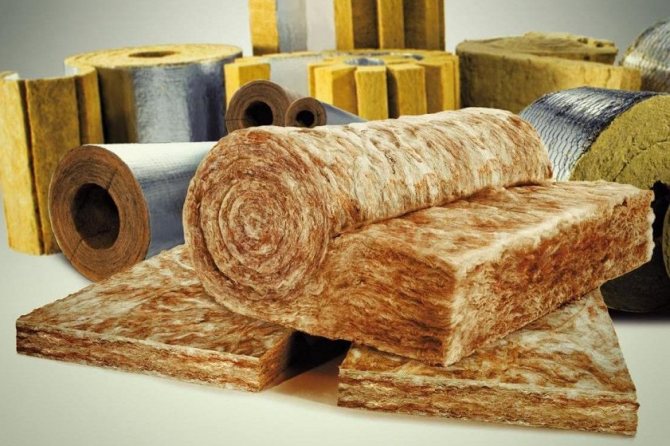

Mineral wool production formats
Slag wool - combustible or non-combustible insulation
To have an idea of the flammability of slag, you need to understand that insulation is the result of mixing blast-furnace slags with binding components. Fibers of the material with a thickness of 4 to 12 microns, a length of 16 millimeters. The peculiarity of the material is residual acidity, respectively, and the ability to react with metal surfaces under the influence of dampness.
Insulation made from slag wool is unstable to moisture, like other more expensive mineral wool materials, and therefore cannot be used for external insulation of facade walls. For the same reason, the insulation is not suitable for the device for thermal insulation of pipes made of plastic and metal. The material is fragile and requires some care during installation and operation.
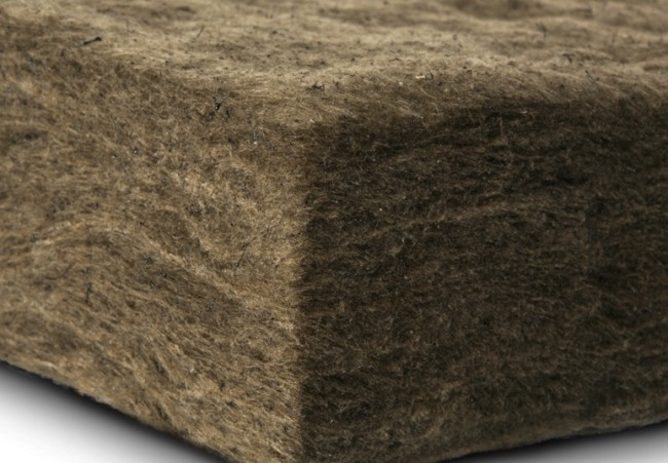

The thermal conductivity coefficient of slag wool is higher than that of the previous insulator. fiberglass. In terms of flammability, the material can hardly be called not vulnerable. The insulation begins to melt at a temperature of 250 degrees Celsius. As soon as the temperature reaches a critical point, the fibers = melt, and with them the functionality is lost.
Liquid fire retardant heaters
These synthetic building materials are characterized by high thermal insulation parameters. Among them, there are many modifications that are non-flammable and ecologically perfect. For example, polyurethane. Liquid fillers fill the smallest gaps, completely preventing cold from entering the premises.
Advantages:
- efficiency;
- environmental Safety;
- fire resistance;
- filling density.
Disadvantages:
- application requires special equipment and skills;
- high price.
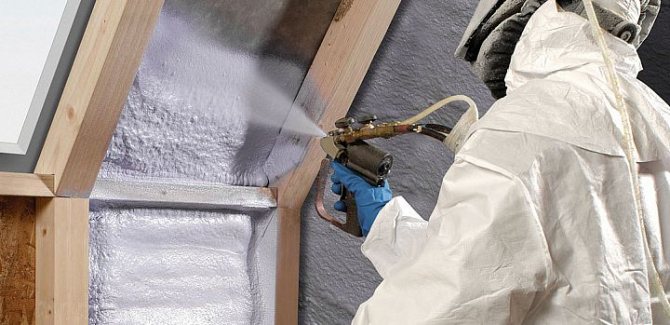

Liquid polyurethane application
Features of using different types of insulation
The use of basalt fiber is recognized as the simplest way to organize a fire barrier, which makes it possible to increase the fire resistance of air ducts up to three hours. Stone fiber is applied by spraying. At the same time, a uniform coating is formed on the treated surface.
Only an experienced operator with specialized equipment can work with such complex material. In addition, this method of creating fire protection requires careful surface preparation (cleaning, priming), this ensures high-quality adhesion of the fibrous material and increases labor costs, which is a disadvantage of this method.
A feature of the formation of a fireproof barrier of an air duct using basalt mats or slabs is the use of a metal band.
The disadvantage of this method is obvious: when the bandage burns out during a fire, the protective layer of the structure is destroyed (disintegrates in parts). But in Russia and on the territory of the CIS countries, basalt fire-retardant systems are widespread due to the cheapness and incombustibility of stone wool.
Fire barrier "Bizon" is a basalt cloth made of connected fibers, covered with foil on both sides. This material is manufactured without adhesives and binders.
Thanks to the polished foil, up to 97% of the heat is reflected, which can potentially be transferred to the ventilation ducts in a critical situation (in the event of a fire). Roll material is supplied in 20 meter lengths, 1 meter wide.
The most effective method of complex refractory protection of ventilation systems... This method is the combined use of rubber-butylphenol mastics and basalt foil sheets of different thicknesses. Stages of the formation of a refractory barrier:
- processing with mastic (heat resistance 1300 ° C) of the surface of the air duct and fasteners;
- wrapping the ventilation duct with basalt cloth (foil layer outside);
- mastic processing of basalt canvas;
- creation of the second layer of basalt canvas.
Loose heaters for walls, ceilings and floors
Each free-flowing non-combustible insulation for walls and ceilings has its own thermal conductivity parameters. When using, you need to accurately calculate the thickness of the backfill. This method of insulation is difficult, both in the development of the project and in execution. Building materials vary in environmental safety, some release toxic substances when heated. But all of them are ideally non-flammable and fireproof.
Advantages:
- good thermal insulation parameters;
- does not attract animals;
- fire resistance;
- low cost.
Disadvantages:
- require accurate calculations and site preparation;
- some modifications emit hazardous substances at high temperatures.
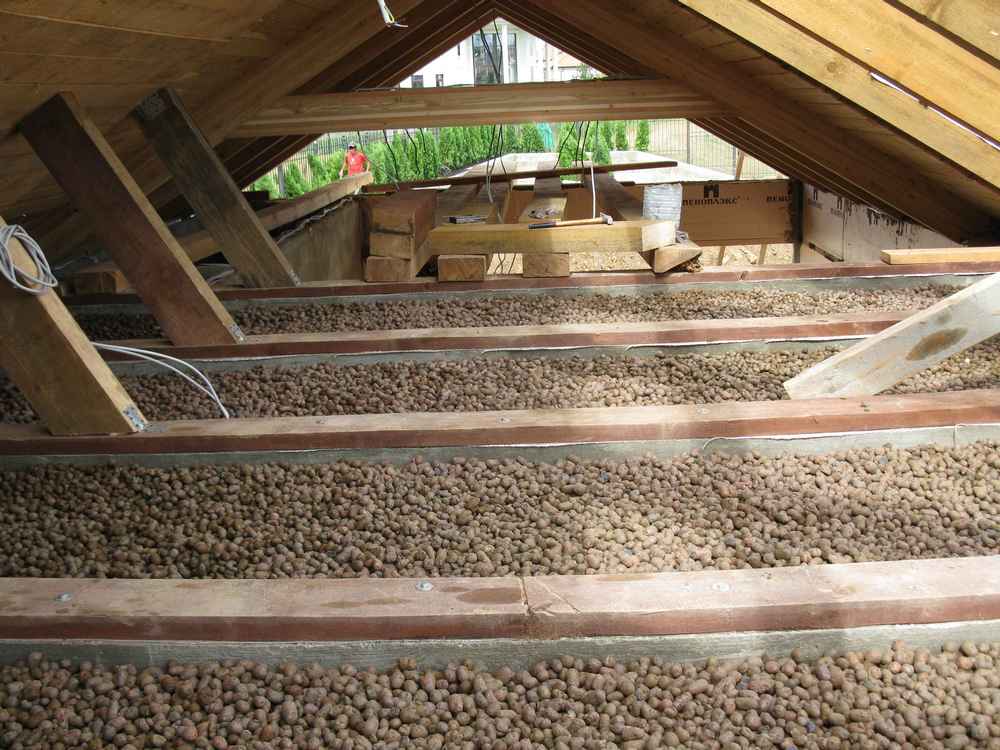

Insulation of the ceiling with expanded clay
Why insulate
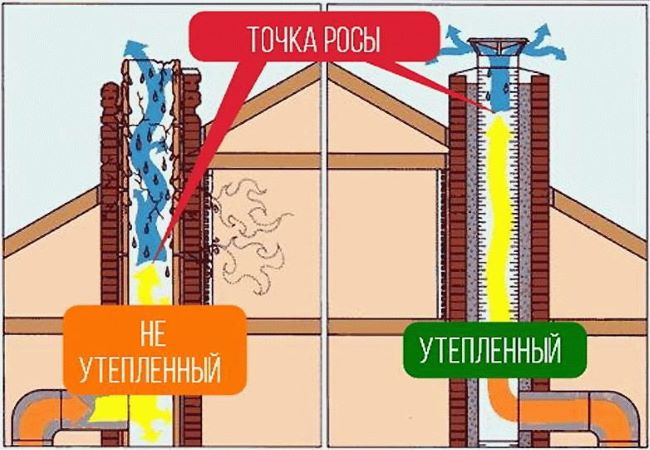

For the correct operation of furnaces or boilers, it is necessary that there is good draft in the pipe. This is especially important when using periodically heated ovens. When the chimney is cold, it is very difficult to immediately start a fire in the furnace. This is explained by the fact that cold air tends downward, and warm air tends upward.
If the height of the chimney is large, then it contains a lot of cold air, which makes it difficult to ignite. If the cross-section of the chimney channel is small, it is recommended to first burn some firewood in the firebox, and then, as it warms up, load it with the calculated amount of fuel.
The soot that forms on the walls of the chimneys also limits the draft. It is formed if the temperature of the gases is not enough to ensure the complete combustion of the volatile fuel particles. At a low temperature of the walls of the chimney, condensate is deposited on them, containing soot particles - products of incomplete combustion of fuel.
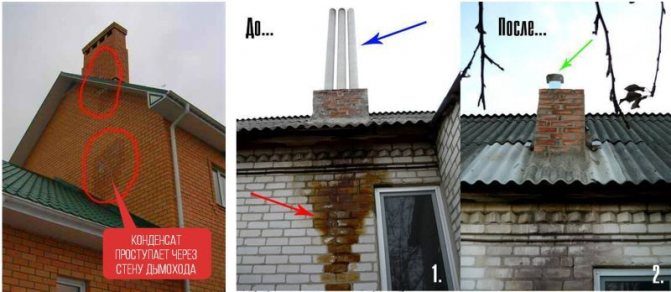

If soot accumulates in the chimney, it may ignite, especially during the subsequent intensive combustion. In this case, the temperature in the pipe can rise many times over and metal pipes can simply burn out.
In addition to soot, condensate contains carbonic and sulfuric acids, which are chemically aggressive substances and can destroy pipe walls.
The above problems with the chimney can be avoided by insulating it from the outside. Then the walls will heat up much faster, and during the furnace there will be no soot formation.
If during the operation of buildings, units with internal combustion engines are used, for example, gas generators for autonomous power supply, then the pipes that go out to the outside for the removal of exhaust gases must also be insulated to prevent the formation of condensation and soot.
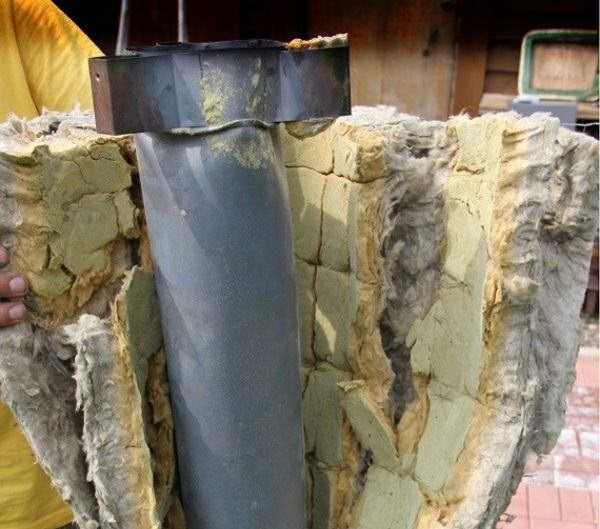

Of course, to ensure fire safety, you need to use only a non-combustible insulation for the chimney, which is sufficiently effective and durable.
Porous insulators with fire resistance parameters
This is the latest generation of fireproof building insulation. Mostly, materials are made from natural raw materials: glass, coal and other components. They consist of up to 80% of voids. Insulation materials do not support combustion, do not emit toxic substances, can be easily cut, suitable for insulating any external and internal structures, including chimneys.
Advantages:
- high thermal insulation characteristics;
- fire resistance;
- low price;
- environmental Safety.
This building material has no shortcomings.


Foam glass production formats
The choice of refractory insulation is an urgent task for many potential owners of country houses. Watch the tests of thermal insulation materials for incombustibility in this video:
Insulation of the chimney pipe with basalt wool ↑
The chimney insulation technology depends on the pipe material, its diameter and a number of other factors.
Basic rules for high-quality thermal insulation ↑
When installing insulation on any type of chimney, it is necessary to check the following standards:
- the thickness of the wool layer in the wooden floor should be 50-100 mm;
- the thickness of the insulation in the passages through wooden structures must be at least 50 mm;
- when laying mats in several layers, the joints of the lower ones should be overlapped by the joints of the upper ones;
- when laying the cylinders in several layers, it is necessary to displace the seam of each subsequent one by 180 degrees relative to the previous one;
- for gas and liquid fuel boilers, it is impractical to use high-temperature cotton wool. The temperature in the chimneys of such systems does not exceed 300 degrees;
- if non-foil material was used as insulation for the chimney from a single-layer pipe, then it is imperative to install a protective screen.
Insulation of a ceramic or asbestos chimney ↑
On a profitable pipe made of asbestos and ceramics, the insulation is installed from the outside, wrapped around and fastened with brackets. To simplify the process, a cylinder made of basalt wool with a thickness of 30-50 mm can also be used.
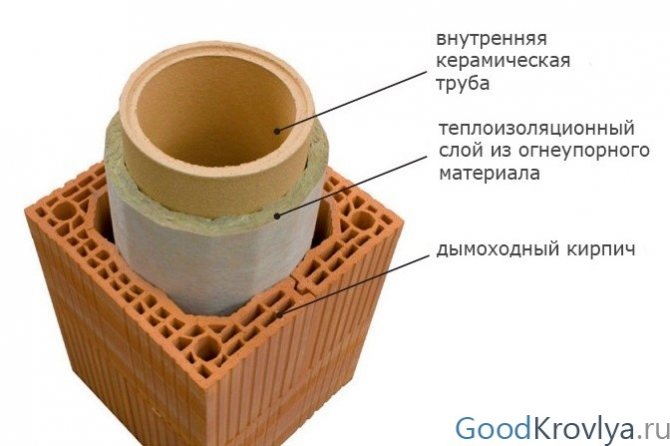

Complex insulation scheme
This method is characterized by the production of an outer casing made of stainless or galvanized steel. The casing consists of individual sections, the height of which does not exceed 1.5 m. The sections are inserted into each other without a gap. The upper end of the chimney is insulated with cement mortar.
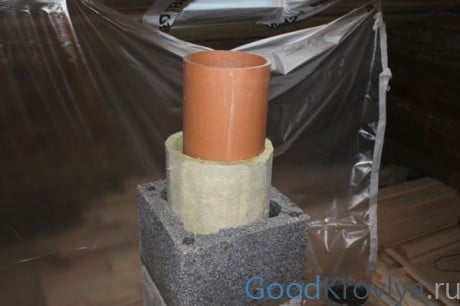

Thermal insulation of asbestos-cement pipes with installation in blocks
In the case of installing a pipe in expanded clay concrete blocks, insulation is carried out during installation, filling the voids between the pipe and the blocks with thermal insulation material.
Methods for insulating a steel chimney
The principle of insulating a chimney made of steel with basalt wool practically does not differ from that used for ceramics.
- Take two pipes of different diameters - smaller for the inner surface, larger for the outer.
- The pipes are inserted into one another.
- The space between them is filled with insulation.
- When installing insulation with a layer of foil inside the room, it is not necessary to use an external casing.
- The end of the entire structure must be insulated.
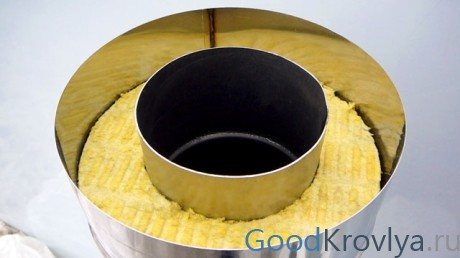

Insulation of a steel chimney
The technology is quite simple, but it can also be simplified by using purchased sandwich pipes, which are insulated pipes for a chimney. Insulation in this case is carried out directly in production, which makes it possible to achieve high thermal insulation characteristics and avoid cold bridges.
Sandwich pipes are lightweight and highly heat-resistant (up to 1000 degrees). The modularity of such systems allows easy installation of any complexity.
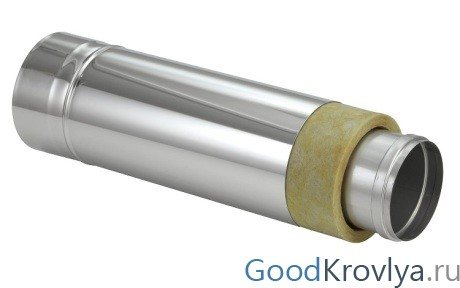

Sandwich pipe device
Brick pipe insulation technology
Insulating a brick chimney is a rather difficult task. To solve it, two main methods are used: plastering and insulation with mineral wool.
For plastering, a reinforced mesh is attached to the outer surface of the pipe. Next, the first small layer with a high liquid content is applied. Then take a break to dry the solution and apply subsequent layers of a thicker solution. The last layer is rubbed and the cracks are closed. For an aesthetic appearance, the pipe is painted or whitewashed.
For insulation with mineral wool, basalt fiber rolls or mats are used. They are cut into pieces, the dimensions of which correspond to the surfaces to be insulated. Then they are glued with tape to the chimney. Next, a protective casing is installed from the second layer of bricks or slabs. The outer surface can be plastered or painted.
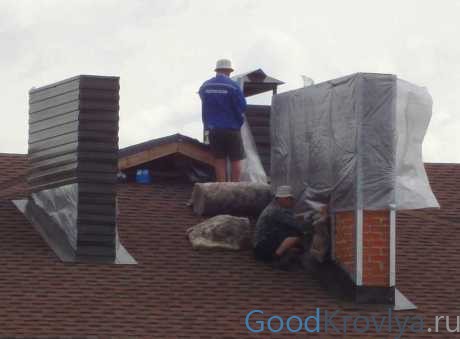

work on thermal insulation of a brick chimney
Basalt wool is a versatile thermal insulation material. It can be used in any room. Not afraid of fire, moisture, vibration, low temperatures.However, for the correct installation of the insulation, it is advisable to contact an experienced specialist who will help you choose the most suitable materials for the chimney, calculate the required amount and select the fasteners. This will save you time and money.
Areas of application of refractory heaters
Non-combustible heat insulators are used at all facilities, including those with high fire safety requirements. They are used on the upper structures of structures: attics, attics, roofs, they are used at facilities with extreme operating conditions: baths, saunas, workshops for the production of hot products, for example, in a bakery. Despite the emergence of new technological materials, traditional insulation is widely used. Such as glass wool, expanded clay, brick breakage are still in demand in construction. Modern heat insulators solve problems at the same time, including vapor barrier. Therefore, when choosing, you should be guided by the recommendations of industry experts.
On a note! All chimneys, regardless of the material - brick, metal, asbestos pipe - are subject to negative influences. That is, any system requires a heat insulator. The choice of insulation depends on the design and material features.
Foil insulators are increasingly being chosen for the construction of baths and saunas. They are lined with walls, floor, ceiling, chimneys. More often this material is sold in rolls. The advantages of this heat insulator are that the foil is characterized by additional properties - to reflect infrared rays. This provides additional heat resistance. The insulation is easily cut and laid, protects the premises from freezing as much as possible at a time when saunas and baths are not used or heated.
Applications
Depending on the type, basalt insulation is used not only to provide thermal insulation for walls, floors, and roofs of buildings. Non-combustible material is indispensable for the formation of a fire belt outside and inside buildings.
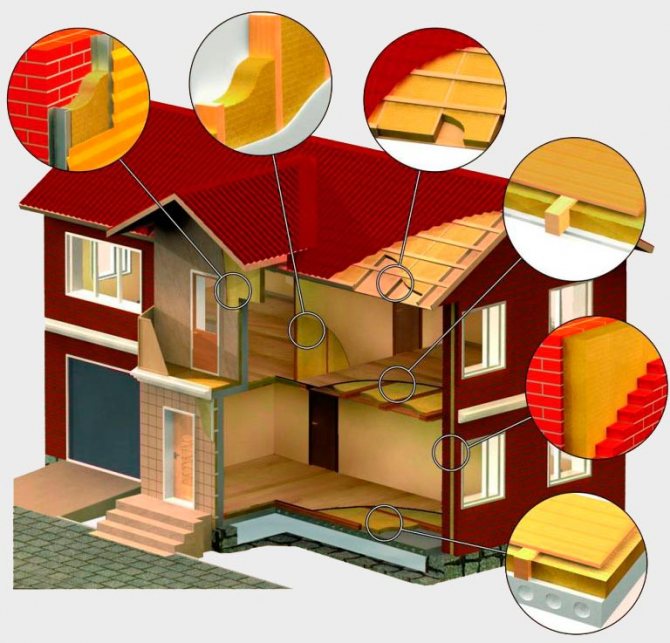

Metal supports, wooden poles, cable ducts of industrial buildings, air ducts and communication elements of air conditioning systems are wrapped in rolls of basalt.
In the event of a fire, fire and smoke spread through the building mainly through ventilation systems that penetrate through several rooms. The metal of the air ducts is capable of deforming and burning out under the influence of high temperatures.
The flame, obeying a forced or natural draft, instantly spreads throughout the structure, and this is dangerous for human life and the safety of property.
The use of basalt fire protection for air ducts, air conditioning systems helps in the event of a fire to prevent depressurization and fires of ceilings at the intersection with ventilation ducts.
Let's summarize
Because, how good the insulation will be, the fire safety of the building depends. It is better to choose products of well-known brands, they exactly correspond to the declared characteristics. Heat insulators of such brands as Rockwool, Rocklight, Technonikol, Isover and Ursa are in demand. These modifications can be bought at low prices in the Leroy Merlin chain stores, Your Home and other retailers. And it is better to entrust the calculations to technologists and engineers who will take into account areas, wall materials, layout and other aspects. As a result, you will live in a comfortable and safe home.
Technical characteristics of basalt insulation
However, it is cheap and environmentally friendly. Expanded clay is characterized by the size of fractions.
The effectiveness of noise and heat insulation works directly depends on the quality of the materials used. Modern insulation, in addition to saving energy, significantly increases the degree of comfort of the room, justifying the efforts and costs of arrangement.One of these materials is rock wool or stone wool. Mineral stone wool is a natural insulation made from rock basalt obtained as a result of solidification of magma.
So, an option up to 5 mm is sand, an indicator up to 40 mm is gravel. If large fractions are crushed, then crushed stone is obtained.
In construction practice, very often it is necessary to deal with the issues of insulation of buildings and other various building structures. This applies to walls, floors, floors, roofs.
Thermal and fire-resistant qualities when using expanded clay are significantly increased. In this article, we will cover in detail the answer to such a question, and what kind of reviews do buyers have about basalt heaters, you will find out all the technical characteristics of the most popular manufacturers of basalt heaters.In this article, we will consider questions regarding the correct installation of basalt wool, how to properly mount and fix it to work surfaces.
And we will also consider issues related to various subtleties that arise during installation.
Mineral wool - goodbye or welcome?
Even now, mineral wool, especially slabs and sandwich panels based on it, is a fairly popular insulation in Russia. Minvata is used for insulating pipes, utility rooms or houses from almost all sides: for insulating walls of a house outside and inside, facades, ceiling, attic, attic, loggia, as well as for sound insulation and sound insulation. Where to buy mineral wool? Everywhere. Sale of mineral wool is carried out in any construction market and on any specialized sites on the Internet.
At the moment, on the Russian market, you can buy many products from mineral wool from various manufacturers. There are various types of mineral wool insulation on the market: foil mineral wool, acoustic mineral wool, stitched mats, insulation cords, sandwich panels, slabs, cylinders, rolls, etc. Mineral wool insulation are produced in various sizes and densities. Of course, an impeccable mineral wool insulation is a dream that has not yet been embodied in a tangible reality. Numerous attempts to create a high-quality thermal insulator for equipping building structures have not yet led to a productive result.
However, the work of engineers and chemists working hard to invent the perfect thermal insulation material based on mineral wool is still not unproductive. The new generation of heaters differs significantly from their historical predecessors in a significant number of technical indicators. In addition to improving technical characteristics, the area of development extended to ensuring ease of installation, increasing wear resistance. There were successes, but it is still necessary to choose and evaluate the advantages and disadvantages.
Those wishing to equip suburban housing or a city apartment with a layer of insulation still have to choose, carefully weighing the shortcomings and convincing advantages of each of the materials. Having summed up the negative and positive qualities, the consumer decides whether the mineral wool is suitable for him. What does a modern buyer need from a heat insulator? The buyer, that is, the owner of a residential or commercial property, a country house or a small summer house under construction, is interested in such qualities of materials for thermal insulation as the minimum operational thermal conductivity, which does not change depending on the complexity of conditions, the absence of thermal expansion and the preservation of structural bonds when exposed to moisture.
Of course, a decent insulation also requires good performance in high and low temperature conditions, operational durability, resistance to biological effects and safety.On many of these points, mineral wool is still able to outperform its competitors.
Unique structure
Before we talk in detail about all the pros and cons of mineral wool as insulation, let's first figure out what mineral wool is.
Stone wool, called "mineral wool" by the builders, is a heat-insulating material with a chaotic fibrous structure. Stone wool is produced from basalt rocks by melting raw materials at a temperature of about 1500 degrees and then exposing the melt to a powerful air flow in a centrifuge, as a result of which basalt fibers are formed. During the production process, special hydrophobic (water-repellent) and binders are added. A pendulum spreader gives a chaotic direction to the basalt fibers, laying out the fibers of the future wool on the conveyor in several multidirectional layers. Further, the material enters the corrugator, which presses the carpet from the fibers. This is necessary in order for the stone wool to acquire the required density.
Then the basalt fibers are placed in a polymerization chamber, where they solidify at a temperature of about 200 degrees, forming the final product. At the last stage, the material is cut into plates of the required size and packed in a special shrinkable polyethylene film.
The properties and genesis of rocks used in the production of insulation predetermine the main advantages of mineral insulation: resistance to fire, resistance to biological negativity, low thermal conductivity. The most widespread and demanded type of stone insulation in construction is basalt wool and mats made on its basis. Stone thermal insulation can be made of slag, diabase, porphyrite, gabbro and other minerals, consisting of silica, including oxides of magnesium and iron.
Leading manufacturers of mineral wool for production use only rocks, since the use of other types of raw materials does not allow obtaining the required quality and durability. But it is precisely these properties that determine the use of the material in critical structures, the service life of which is measured in decades. Therefore, cotton wool made from blast-furnace slag is not suitable for these purposes - it can lose its properties under loads, temperature drops and increased humidity. But for summer cottage construction, it is quite suitable, since it is much easier to carry out repairs there.
At the moment, on the Russian market, you can buy mineral wool from various manufacturers. From domestic it follows about how the largest of them. As for foreign manufacturers, Izomat a.s. companies are widely represented on the domestic market. (Slovakia), Rockwool (Denmark), Paroc (Finland) and Knauf (Germany).
Mineral wool has several characteristics that distinguish it from other types of insulation. These characteristics include high heat and sound insulating ability, incombustibility, resistance to temperature deformation. As well as almost zero hygroscopicity and chemical and biostability.
The thermal conductivity of a material is related to the thermal conductivity of a rigid environment, air and moisture contained in the pores. Mineral wool with randomly arranged fibers is the most suitable heat insulator. The strength of mineral wool depends on the ordering of the fibers. The more vertical fibers, the stronger the thermal insulation of the mineral wool.
The mechanical properties of the mineral wool are also influenced by the orientation of the fibers. But in a different dependency. The more vertically oriented fibers the mineral wool contains, the higher its compressive strength. This fact allows the use of mineral wool of lower density without sacrificing strength.For this reason, at present, there is an intensive development of production technologies that make it possible to obtain such plates. Of the general characteristics, it is also worth noting that the shrinkage of mineral wool is so small that it can not be taken into account at all. During the entire service life, mineral wool materials retain their geometric dimensions and do not shrink. Thus, "cold bridges" are not formed at the joints of the insulation boards. If we talk about hygroscopicity, then it is very low in mineral wool boards, as well as shrinkage. Under normal conditions, it is 0.5 percent by volume. But often on a construction site, storage and installation takes place in conditions of high humidity, for example, during rains. To prevent cotton wool from absorbing excess liquid, it is most often impregnated with water repellents - water-repellent compounds. These are either special oils or organosilicon compounds.
Mineral wool insulation has a high chemical resistance. Moreover, mineral wool is chemically inert and does not cause corrosion upon prolonged contact with metals. Practice has shown that after very long (more than thirty years) periods of operation, mineral wool products retain their mechanical and thermal insulation properties. Another advantage of mineral wool is that, in addition to excellent thermal insulation characteristics, mineral wool also has good sound insulation properties. Walls filled with mineral wool significantly reduce the likelihood of standing sound waves inside them. This means that the noise from the street inside the building will not be heard. Passing through the layer of material, sound waves are attenuated, and due to this, the sound level of the room is significantly reduced. Ease of installation can also be added to the treasury of the advantages of mineral wool products. The low weight of the plates, the dimensions convenient for installation, the ease of processing - all this undoubtedly increases the speed of installation of the insulation.
Does not burn in fire, does not drown in water
The most important priority of using mineral wool over other insulation materials is its special temperature resistance. Mineral wool does not burn. The Fire Safety Requirements classifies it as non-combustible material (NG). Moreover, due to its ability to prevent the spread of fire, mineral wool can be used as fire protection. Thermal insulation made from mineral wool can be used at high temperatures, as it can withstand temperatures above 1000 degrees. As the temperature rises, the binding fibers begin to burn (they burn at 250 degrees), but the structure of the mineral wool itself will be intact and not oxidized, thereby creating a fire barrier, however, provided there are no mechanical influences.
Another important quality of non-combustible basalt mineral wool insulation of any density is their high vapor permeability in the production of thermal insulation. Water vapor contained in the air (especially baths, saunas) freely pass through the mineral insulation without condensing in it. At the same time, the basalt insulation always remains dry and does not lose its heat-shielding properties. Excellent vapor permeability of mineral basalt insulation, low thermal conductivity contribute to maintaining a healthy microclimate in the interior of the insulated building of a bath, sauna, sports and recreation complexes. Due to the property of letting through the evaporation of mineral wool, it is actively used for the arrangement of wooden houses. After all, the advantages of natural organic matter lie in the ability to spontaneously remove household steam outside the building's contour, and any other type of insulation can deprive wood of one of its central advantages.
If we take into account the simplicity of the production of mineral wool insulation, as well as the non-scarcity and cheapness of raw materials, then the mineral wool turns into an irreplaceable and versatile heat-insulating material that is extremely in demand in construction and industry.
However, mineral wool also has disadvantages. In particular, under constant exposure to dampness, its thermal insulation properties decrease. Usually, the warranty period for the use of mineral wool insulation is no more than twenty-five years, sometimes less, and replacing the insulation will cost a penny at all, taking into account repeated finishing work. However, this minus is lost against the background of more serious claims made to the mineral wool in recent years.
Ministry of Health does not recommend
Due to the wide distribution and cheapening of competing heaters, such as silicate fiber, expanded polystyrene foam, polyurethane foam, polyethylene foam, penoizol, etc., as well as thermal insulation based on vegetable raw materials, many construction companies refuse to insulate their facilities with mineral wool because of serious harm caused mineral wool ecology and human health. In fact, despite the familiarity and versatility of the application, mineral wool, nevertheless, is more and more objectionable. Of course - the thermal insulation properties of this material remain beyond any claims, but we have to admit that mineral wool hides some danger.
By itself, mineral wool does not pose a danger to human health - its fibers are made from environmentally friendly natural materials. Unsafe is the substance used in the formation of the "carpet" - a binder, as well as the smallest fibers of mineral wool. What are we talking about?
The fact is that phenol-formaldehyde binders that emit harmful volatile substances are used in the production of mineral insulation. Both phenol and formaldehyde are poisonous and belong to the second class of hazard (highly hazardous substances). Formaldehyde is highly toxic, has allergenic, mutagenic and carcinogenic effects, can provoke skin diseases and diseases of internal organs, negatively affects genetic material, reproductive organs, respiratory tract, eyes and skin. Phenol in the form of vapors or dust irritates mucous membranes and skin, and with regular exposure leads to chronic liver and kidney diseases. It has a strong effect on the central nervous system, can lead to leukemia. Meanwhile, phenol and formaldehyde can be released from mineral wool throughout its entire service life. The percentage of the binder, depending on the density of the mineral wool product, ranges from 3 to 6 percent.
According to doctors, phenol is very quickly absorbed into even intact areas of the human body. Almost immediately after the substance enters the body, phenol begins to affect the brain, causing short-term arousal, and possibly paralysis of the respiratory center. Even minuscule fractions of this component cause a cough, headache, nausea, and fatigue in a person. More serious poisoning can lead to fainting, corneal numbness, seizures, and cancer. People who have lived near a phenol source for a long time may have children with physical and mental disabilities.
As for formaldehyde, according to a number of experts referring to ongoing research, some samples of mineral wool can release up to 0.02 mg of this component per square meter of plate surface per hour. Taking into account the fact that there are many other sources of this highly toxic substance in a residential building (particle boards, plywood, etc.), as well as taking into account its intake from street air, the maximum permissible concentration (0.05 mg / m³) of formaldehyde can be exceeded in repeatedly.
According to recent studies, during long-term operation of slabs, mats, sandwich panels made of mineral wool with a density of 74 kg / m³, thermal conductivity increases by 2.8 times, with a density of 156 kg / m³ - 1.9 times. A blowing wind with a speed of up to 0.7 m / s increases the thermal conductivity of mineral wool by 60 percent. Accordingly, the weight of the mineral wool decreases. Thus, the thermal conductivity coefficient of mineral wool depends on its service life.
It would seem that a good repair has been made in a completely new apartment, which has been furnished with just purchased furniture. And suddenly the tenants begin to suffer from bouts of allergies, or even signs of cancer appear. Children, the elderly and people with poor health are especially sensitive and quick to respond to such changes. Some not only environmentalists, but also doctors believe that this is due to phenol, formaldehyde, which are emitted by various types of building materials. Mineral wool or asbestos dust makes a negative contribution here. Alas - such dust is measured in microns and does not lend itself to destruction with a vacuum cleaner, while "generously" settles in the lungs. Such dust has a toxic effect on the respiratory organs, causing attacks of allergies.
In Russia, there are questions about mineral wool Chief Sanitary Doctor of the country Gennady Onishchenko
:
- A person moves to a new apartment, he has headaches, pressure jumps, he cannot find a place for himself. When we start checking, in the finishing materials we find many violations of technology - the release of the same formaldehydes. It comes to the point that we give an order to tear off everything and redo it again. But this is when the person complained. And most do not complain, - he noted.
Mineral wool must comply with all the requirements that apply to it, warned Mr. Onishchenko. If elementary technology is violated during its manufacture and regulations during construction are violated, then the use of such materials can lead to very serious health consequences, the chief sanitary doctor of Russia emphasized.
Unfortunately, cases of such diseases are becoming widespread, as, for example, the history of the "phenolic houses" of Metrogorodok in Moscow - its residents bombarded the authorities with indignant letters about the growth of cancer among residents of such apartments. What should owners of apartments with such an insulating material do? Of course, if possible, change it to another - less dangerous, since the choice today is quite large. If this is not possible, wet cleaning in all rooms as often as possible, intensively ventilating them, and family members actively strengthening their health, increasing immunity.
Manufacturers of mineral wool, for their part, claim: the phenol-formaldehyde binder used in the technological process is in mineral wool in a small amount and in a bound, polymerized state that does not pose a threat to humans, provided that the established installation rules are observed. Confirmation of this, they say, are environmental certificates obtained after testing materials in Rospotrebnadzor. However, there are other data as well. The negative effect of carcinogenic components - dust and phenol-formaldehyde resins on the human body has been studied for a long time. As a result, for example, the European Union in 1997 was forced to publish the classification of this insulating material according to the degree of danger. According to this document, mineral wool was considered an irritant - an irritant and was considered potentially hazardous - depending on the size of the fibers and the content of various alkaline oxides or alkaline earth metals in it. In a number of countries around the world, a fairly tough approach has been taken to assessing artificial mineral fibers. For example, Germany has completely abandoned their use.
On the other hand, the International Agency for Research on Cancer (IARC) in 2001 prepared a report on the assessment of carcinogenicity of artificial mineral fibers, according to which glass (continuous fiberglass), rock and slag wool are classified in group 3 according to the degree of danger. In 2009, these data were confirmed in the United States by the organization NTP (National Toxicology Program). At the same time, mineral wool made from refractory ceramic fibers and from some types of discontinuous fiberglass is assigned to group 2B according to the degree of danger (for these types of mineral wool, there is reasonable evidence that it is carcinogenic to animals).
Of course, it is difficult to give an unambiguous answer if a person suddenly becomes ill, because in our everyday life we are surrounded by a lot of different factors. However, doctors state that such patients have appeared, which means that it is time to pay more attention to those building materials that we use.
Will Minvata still serve?
At the same time, one should not assume that mineral wool has completely outlived its age. Often, critical statements against mineral wool insulation are the consequences of competition for sales markets or even technical illiteracy.
Leading manufacturers of thermal insulation materials use high-quality raw materials of natural origin. In Western Europe, in many countries, mineral insulation has been used for decades and, despite the high environmental requirements, is recognized as a suitable technical solution. Constant control over production processes allows us to obtain high-quality materials that meet European and international quality standards.
However, the criticism is partly fair. The fact is that the production of mineral wool was mastered by companies with weaker production potential, using inexpensive improvised raw materials for the production of thermal insulation materials, including waste from the metallurgical industry, namely slags. The quality indicators of these materials are at a lower level, and the chemical composition includes half of the periodic table. However, this heat insulator is also called mineral wool and is used by construction companies looking to save money.
Leading companies use high-quality resole resins of a new generation, which are present in the final product in a solid, infusible and insoluble state, which significantly reduces the likelihood of the release of harmful substances from mineral wool. Moreover, the current trend is to use alternative types of binder, which are less hazardous to humans. Such products are positioned by manufacturers as exceptional quality and are produced, as a rule, under their own separate brand, and at the same time it is the same mineral wool. Just getting improved properties. I think that it is in the direction of greater safety of mineral wool for human health that the leading manufacturers of this product will continue to move, and mineral wool will serve people for a long time.


